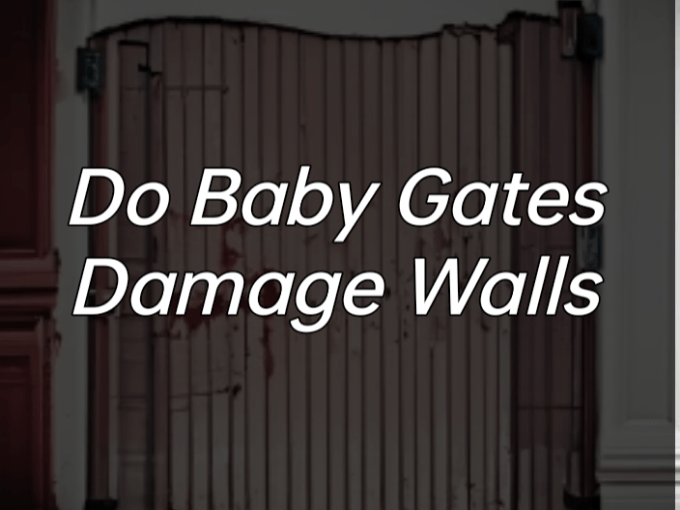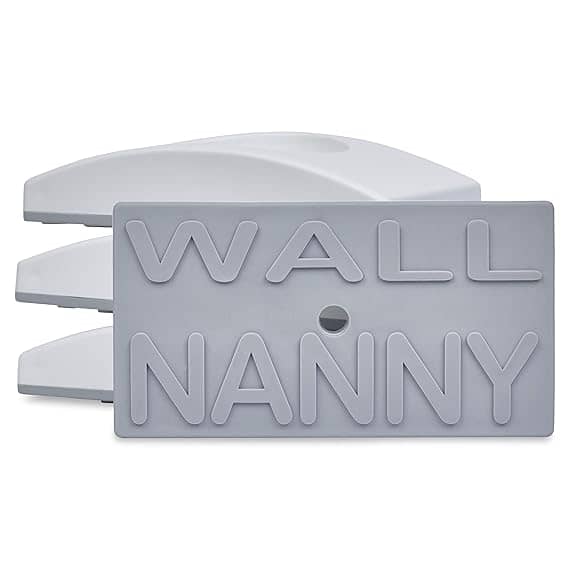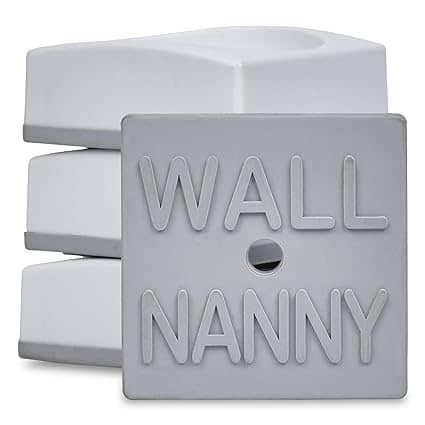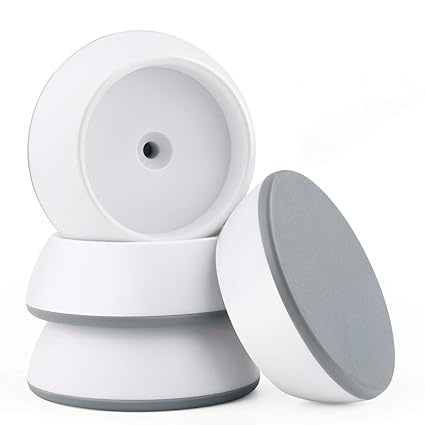Table of Contents
ToggleAre you a parent struggling to contain your children and curious about do baby gates damage walls? You’re not alone! Many parents wonder if their household safety tool will cause irreparable damage or warrant costly repairs. Whether you’re hesitating to take the plunge into installing baby gates or already have them in place, this blog post is here to help.
Do Baby Gates Damage Walls - Exploring the Pros and Cons
Most baby gates are designed to be installed without any permanent fixtures, making them ideal for growing families.
Before installing a baby gate, you should consider the type of wall that it will be placed on. For instance, drywall is more prone to dents and scratches than plaster or stucco walls.
You may also want to consider adjusting the position of the gate if it will be placed on a wall with wood trim, as the hardware may cause some wear and tear.
Alternatively, you could opt for pressure-mounted baby gates that are easier to install and remove without causing any damage to your walls.
However, take caution when using this type of gate; many models do not have the same sturdy construction as those anchored to the wall, and therefore may not provide the same level of security.
No matter which type you choose, take extra precautions when installing your baby gate to prevent any damage from occurring.
Ensure all mounting hardware is securely fastened and regularly checked to be properly secured before use.
These steps will help minimize the risk of injury and ensure that your walls remain in good condition.
Above all, remember that safety should be your top priority when choosing the right baby gate for your home. It’s necessary for you to!
Understanding the Basics of Baby Gates and How They Work
Baby gates function as mini barricades in your home, allowing you to cordon off areas that might pose potential risks to your adventurous little ones.
They come in various designs and sizes, ranging from simple and traditional to innovative and modern, with features such as auto-lock mechanisms or one-hand operation for added convenience.
Key to their design is their versatility and adaptability, with adjustable widths to suit different doorframes or staircases, and extensions available for larger areas.
Some are even designed to withstand the outdoor elements, allowing you to create safe play zones in the yard.
Importantly, baby gates are designed to withstand a toddler’s curious hands (and sometimes the full weight!),
ensuring they stay robust and securely in place even with a little extra pressure applied. However, the right installation and ongoing maintenance are crucial to ensure their effectiveness and longevity.
Types of Baby Gates You Can Choose From:
There are a few key options when it comes to baby gate design, so you can find the best one for your home.
Hardware-Mounted Baby Gates:
Hardware-mounted baby gates are generally considered the sturdiest and most secure option.
They are secured to the wall or doorframe by drilling holes and using screws, which gives them a high level of stability.
These are particularly recommended for use at the top of stairs or other potentially dangerous areas where a fall may occur.
Pressure-Mounted Baby Gates:
Pressure-mounted baby gates are a popular choice for parents who want a temporary, easy-to-install option.
These gates operate by applying pressure against the walls or doorframes to hold them in place.
They are an excellent choice for separating rooms or blocking off areas on the same level. They’re not recommended for use near stairs, though, because they may not withstand the force of a child pushing against them.
Retractable Baby Gates:
Retractable baby gates are a relatively new addition to the market, offering a modern, sleek design that doesn’t compromise on safety.
They operate via a flexible mesh screen that retracts into a slim, unobtrusive housing when not in use, making them ideal for tight spaces or areas where a swinging gate would be inconvenient.
Free-Standing Baby Gates:
Free-standing baby gates are designed to stand upright on their own without the need for any installation.
They’re versatile and portable, making them ideal for travel or temporary set-ups. However, they’re best used in situations where they won’t be pushed or pulled on excessively, as they may be less stable than mounted options.
For detail information about baby gates types and Know which baby gates type best for you? This article special for you. Which type of baby gates are best?
Factors to Consider When Choosing a Baby Gate:
When selecting a baby gate for your home, it’s important to consider safety as the number one priority.
Make sure you choose a model that is designed and tested for use with children and always follow the manufacturer’s guidelines when installing and using your baby gate.
Other factors to consider include ease of installation, whether you require a permanent or temporary option, and the size of the gate to fit your doorway or staircase.
For stairs, you’ll need a stairway gate that extends over the top step as well as shorter models for other areas.
It’s also important to choose a baby gate that is suitable for your needs. For example, if you require an extra-wide gate or one that is suitable for outdoor use, make sure you select the right model.
Finally, while most baby gates are designed to be safe and secure, it’s still important to keep a watchful eye on your little ones when possible and use common sense at all times.
With the right precautions in place, you can ensure that your home is a safe and secure environment for your family.
Though baby gates can be incredibly useful, it’s important to remember that they are not a substitute for adult supervision and should never be used as such.
So make sure you’re always there when needed in order to keep your children as safe as possible!
The Pros and Cons of Installing a Baby Gate:
Pros of Installing a Baby Gate:
- Safety: Baby gates provide an additional layer of safety by preventing young children from accessing dangerous areas such as stairs, kitchens, and bathrooms.
- Peace of Mind: They offer parents peace of mind, knowing that their curious little ones are safe from potential hazards within the home.
- Versatility: With a variety of types and designs available, they can be used in multiple locations throughout the home.
- Easy to Install: Many baby gates are easy to install and can be relocated as needed.
- Convenience: Features such as one-hand operation and auto-lock mechanisms make baby gates convenient for busy parents.
Cons of Installing a Baby Gate:
- Potential for Damage: Hardware-mounted gates can cause minor damage to walls or doorframes during installation.
- Limited Mobility: They can limit mobility within the home for other family members, particularly in tight spaces.
- False Sense of Security: While they enhance safety, baby gates can sometimes provide a false sense of security. They are not a substitute for active supervision.
- Cost: High-end, feature-rich baby gates may be costly for some families.
- Inconvenience: Some models can be difficult to operate, potentially causing inconvenience.
Steps to Avoid Causing Damage to Walls while Installing a Baby Gate:
- Choose the Right Type of Baby Gate:
If you are concerned about damaging your walls, consider using a pressure-mounted or free-standing baby gate. These types of gates don’t require any drilling or screwing into the walls, thereby minimizing potential damage.
- Use Wall Protectors:
Wall protectors are a great way to reduce the impact of baby gates on your walls. They distribute the pressure over a larger area, reducing the likelihood of damaging the wall surface. These can be particularly useful with pressure-mounted gates.
- Install Correctly:
Ensure you follow the manufacturer’s instructions to the letter when installing the gate. Incorrect installation can lead to unnecessary damage to the walls. If you’re unsure, consider hiring a professional to do the job.
- Consider Padding:
If your baby gate has hard edges or corners, consider adding padding in these areas to protect your walls. You can find special padding designed for this purpose, or you could use basic foam padding.
- Regular Maintenance:
Regularly check the gate to ensure it’s still securely in place and not gradually damaging the wall. If you notice any signs of damage, you may need to adjust or move the gate.
By using a careful and considered approach, you can significantly reduce the chance of your walls being damaged by the installation of a baby gate.
With the right care and maintenance, baby gates can be a great way to keep your home safe without damaging your walls. For more information on how to safely install and use baby gates, check out our blog post on Safe Baby Gate Installation Tips.
You can also contact a qualified home improvement professional to ensure your gate is secure and installed correctly.
How to Protect Your Walls When Using a Baby Gate?
Baby gates can be a great way to keep curious children away from potential dangers, but if you’re not careful they can also cause damage to your walls. To avoid this, make sure you:
- Choose the right type of baby gate for your needs (e.g., pressure mounted or free standing)
- Use wall protectors when possible
- Follow manufacturer’s instructions carefully when installing
- Consider padding hard edges or corners of the gate
- Regularly check that the gate is still securely in place and not gradually damaging your walls.
By taking these precautions, you can ensure that your baby gate keeps your children safe without causing any damage to your home.
And of course, it’s always important to remember that baby gates are no substitute for adult supervision.
So make sure you’re always there when needed in order to keep your children as safe as possible!
Uninstalling Baby Gates:
Steps and Precautions to Uninstall a Baby Gate Without Damaging the Wall:
- Read the Manufacturer’s Instructions: Start by reading the manufacturer’s instructions for uninstalling the baby gate. They will provide the safest and most effective method for removing the gate without damaging your wall.
- Use the Correct Tools: Ensure you have the correct tools on hand for uninstalling the gate. If you used screws to install the gate, you might need a screwdriver or drill. Using the right tools can prevent unnecessary wall damage.
- Remove Slowly and Carefully: When removing the baby gate, do it slowly and carefully. Rushing the process can result in accidental damage to your wall.
- Use a Putty Knife to Remove Wall Protectors: If you used wall protectors, gently lift them off with a putty knife. This will help to prevent paint or wallpaper from peeling off with the protector.
- Repair any Marks or Holes: After removing the gate, check the wall for any marks or holes. If there are small holes from screws, you can fill them with a small amount of wall filler or putty, then repaint the area if necessary.
- Clean the Area: Lastly, clean the area where the gate was installed. Remove any dust or residue to leave your wall looking as good as new.
By following these steps and precautions, you can uninstall your baby gate safely without causing any damage to your wall. Always remember to be patient and careful during the uninstallation process.
Conclusion:
In conclusion, while baby gates are a crucial tool for protecting toddlers from potential household hazards, they can pose certain risks to the aesthetics and structural integrity of your walls.
Whether or not a baby gate damages your wall largely depends on the type of gate, the installation process, and the maintenance practices that you employ.
Hardware-mounted gates, which require screws and brackets, can cause minor damage to walls or doorframes. However, this can be minimized or entirely avoided through correct installation and the use of wall protectors.
Pressure-mounted or free-standing gates, on the other hand, pose less risk of wall damage. Regular monitoring of the gate and wall condition is essential to prevent gradual damage over time.
Ultimately, with careful selection, proper installation and regular maintenance, baby gates can serve their important protective function without compromising the condition of your walls.






6 thoughts on “Do baby gates damage walls?”